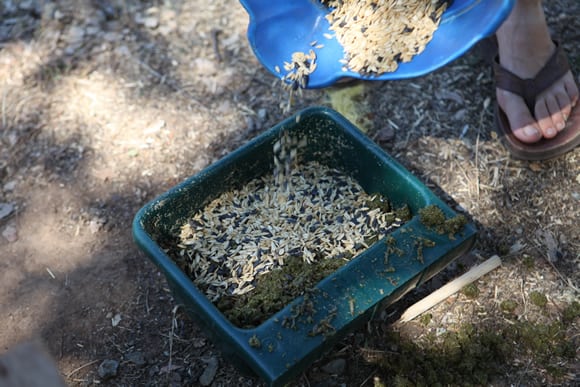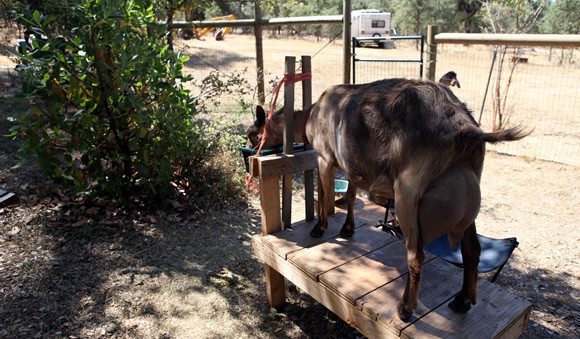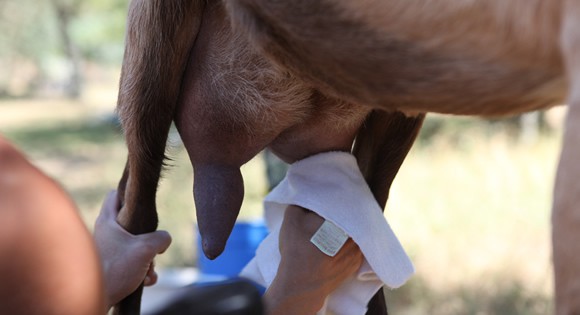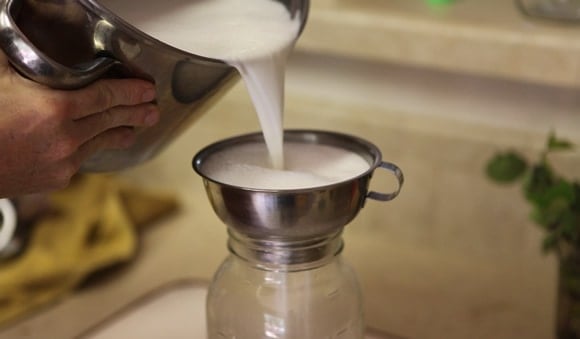When a person or family starts down the path of building resiliency into their lives, many projects and tasks get added to an ever-growing list of things to do. Store water, put away some extra food, evaluate your energy use, and consider the various scenarios where your preparations and skills might be tested. For many people, putting in a garden is a big step toward resiliency building. There is a lot to learn. But once that garden is in place and you get that great tasting produce in your belly, you start to think about expanding operations. What about chickens? Fresh milk would be really great! It can be a slippery slope towards complete self-sufficiency. If you have the space and an adventurous nature, you might consider getting a few dairy goats to provide incredible milk (which can, of course, also be used for making cheese and yogurt) and to be used for weed and brush control.
Dairy goats can be an easy-to-manage and enjoyable way to provide fresh milk on a daily basis, but having some background information about what it will take to get that milk is important. The intent of this article is to give you a working understanding of the milking process as one of the components to make raising and working with dairy goats enjoyable and rewarding.
The Daily Milking
Initial Preparation
Sterilization & Equipment
Before every milking, all equipment must be cleaned and sterilized. This includes the milking pail, milk strainer, jars, and lids. We use a stainless-steel seamless cooking pot as our milking pail. We find the easiest way to sterilize our milk pail is by putting the milk strainer into the milk pail with a few inches of water, put a lid on the pot, (pail), and boil for 10 – 15 minutes. We run the quart and half-gallon glass mason jars and lids through the dishwasher on a high-temp wash. If you are milking a lot of goats, a milk tote can also be a handy tool.

Udder Wash & Towels
Prepare your udder wash. This wash solution is used to clean the udder and teats and remove any dirt and particles that might fall into the milk pail. Commercial udder washes are available, but we find that a solution consisting of hot water and a few drops of liquid dish soap works quite well. Some people also use a few drops of bleach to ensure a sterile milking environment. Clean washcloths or paper towels can be used.
Grain / Feed Buckets
Feeding a goat during milking keeps them happy on the milk stand. Many commercial dairy goat feed mixes are available, or you can mix your own. We use a special grain bucket that fits right onto our milk stand.

Goat on the Milking Stand
Now that your initial preparations are done, now is the time to lead your goat to the milk stand (also known as a stanchion). Once goats have been trained and become accustomed to being milked, they will jump right onto the milk stand. Feeding them on the stand is good incentive. Secure the goat onto the milk stand.
Wash and Prep
Sit next to the goat. We prefer to sit right next to ours on a stool or chair, facing her udder. Brush the goat prior to each and every milking. This removes loose dirt and debris, which could otherwise end up in the milk. Then use your udder wash to thoroughly wash the udder and teat. It’s helpful if your goat has had her udder and underbelly shaved, which we try to do prior to kidding. Thoroughly dry off the udder and teat. The first few squirts of milk from each teat should be put into a separate squirt cup (any separate container will do). This is to check for any abnormalities, which can help indicate early stages of mastitis.

Milk out the Goat
Now it's time to milk the goat. Put your sterilized milk pail onto the milk stand under the goat. Place one hand on each teat. The milk is made and stored in the udder and passes through the teat. To milk a goat, you first must cut off the milk within the teat by closing the top of teat between your thumb and first finger. Then squeeze the teat starting at the top and move the motion down the teat by closing off each finger down your hand. Check out our video link (below) for a visual of how this works.
After each squirt into the milk pail, release your hand so milk can refill into the teat, then start again. Continue milking until the goat is milked.
[embed]https://s3.amazonaws.com/cm-us-standard/video/goat-milking2.mp4[/embed]Finishing Up
Filtering and Storage
Take your milk into the kitchen and filter it through a milk filter into your sterilized jars. To get the milk cold quickly, we keep our milk in the freezer for about 90 minutes, then transfer it into the refrigerator, where we store it for up to 10 days. Though it never last more than 3 or 4 days in our house – we enjoy it too much!

Washing Up
Wash all of your equipment carefully. It is best if the milk equipment is washed right away. Start by rinsing with warm (not hot) water. After the initial rinse, use hot soapy water to thoroughly wash. Sterilize your milk pail and filter so they are ready for the next milking.
Tips and Considerations
- Kicking on the stand – Sometimes a goat will kick because it is sore, out of grain, or just not yet used to being milked. A goat hobble can come in handy if you have a kicky goat.
- Teat size – A larger teat size tends to be easier to manage when milking. It gives you more milk per squeeze, and you won't get tired too quickly. Before buying a goat, really take a look at her udder and teats and do a practice milking if you can.
- De-wormer application - We give a scheduled herbal de-wormer during the milking to ensure that it gets eaten.
- Milk stand construction - There are lots of plans online for milk stand construction, as well as many people building them for others. We build ours out of pallet materials and recycled lumber.
This is a companion discussion topic for the original entry at https://peakprosperity.com/milking-a-goat-by-hand/